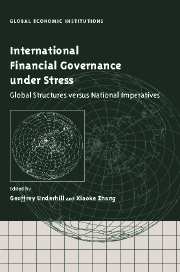Book contents
- Frontmatter
- Contents
- List of figures
- List of tables
- List of contributors
- Acknowledgements
- Introduction: global market integration, financial crises and policy imperatives
- I Financial globalisation and policy responses: concepts and arguments
- 1 Reform of the international financial architecture: what has been written?
- 2 Costs and benefits of financial globalisation: concepts, evidence and implications
- 3 Capital controls: the neglected option
- 4 Global structures and political imperatives: in search of normative underpinnings for international financial order
- II Globalisation, financial crises and national experiences
- III Private interests, private–public interactions and financial policy
- IV Building the new financial architecture: norms, institutions and governance
- Conclusion: towards the good governance of the international financial system
- Index
1 - Reform of the international financial architecture: what has been written?
Published online by Cambridge University Press: 22 September 2009
- Frontmatter
- Contents
- List of figures
- List of tables
- List of contributors
- Acknowledgements
- Introduction: global market integration, financial crises and policy imperatives
- I Financial globalisation and policy responses: concepts and arguments
- 1 Reform of the international financial architecture: what has been written?
- 2 Costs and benefits of financial globalisation: concepts, evidence and implications
- 3 Capital controls: the neglected option
- 4 Global structures and political imperatives: in search of normative underpinnings for international financial order
- II Globalisation, financial crises and national experiences
- III Private interests, private–public interactions and financial policy
- IV Building the new financial architecture: norms, institutions and governance
- Conclusion: towards the good governance of the international financial system
- Index
Summary
The financial crises of the 1990s, following two decades of financial market liberalisation and ever growing capital flows, have prompted a passionate debate about ‘globalisation’ as the successor world system to the Cold War. The background to these crises is a story well told, stretching from the breakdown in the Bretton Woods system in the 1960s, the confirmation of the dollar as the world's reserve and transaction currency, the recycling of funds following the rise in oil prices, and the expansion of the financial marketplaces in London and New York. This in turn prompted a scramble among developed countries to open their securities markets to institutional investors, who demanded the liberalisation of capital controls as the price for their presence. Liberalisation of capital movements then spread to developing countries. Initially, resistance was loud, but as time passed and US hegemony became entrenched, even major financial meltdowns – such as the devaluations of the Italian lira and pound sterling in 1992, or the collapse of the Mexican peso in late 1994 – attracted only temporary attention. By the mid-1990s, confidence in dominant policy prescriptions reigned supreme. Asia's financial crash therefore came as a shock, the equivalent for economists of the Soviet Union's collapse for sovietologists, all the more severe in that it was unpredicted and its severity unanticipated.
- Type
- Chapter
- Information
- International Financial Governance under StressGlobal Structures versus National Imperatives, pp. 21 - 40Publisher: Cambridge University PressPrint publication year: 2003
- 1
- Cited by



